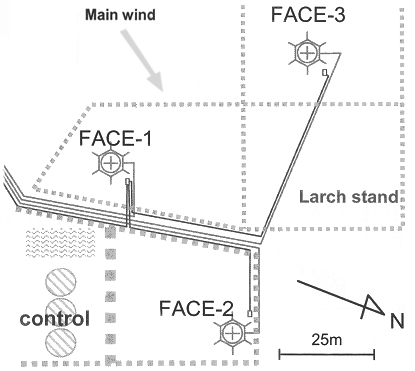 | FACE (Free Air CO2 Enrichment) experiment for mixed broadleaved tree species |
|
Control plot |
FACE plot |
Scheme of experimental plots |
My part: Soil respiration
This study examined the variations of soil respiration under elevated CO2 during growing season of 2005 at the Free-Air CO2 Enrichment (FACE) at the experimental nursery of Hokkaido University Forests (Sapporo, Japan) as a model for near-future climate changes. The FACE facility employed the design described in Hättenschwiler et al. (2002), and it was constructed in 2003. The experiment began treatment exposure (enriching with CO2) in 2003 and ended in 2007. Monitoring and control equipment are stored in small sheds next to each plot, and maintained target CO2 concentrations. Using FACE technology, model forest stands at developing stages were established in three experimental plots of hexaedr form with 7 m in diameter treated with elevated CO2 (550 ppm, approximately 130 μmol mol-1 above the control (Eguchi et al. in press a)) during the day (12 hours) ¢ ōelevated [CO2]ö, and another 3 experimental plots of similar characteristics were used as a control plots (ōambient [CO2]ö) of same diameter with ambient CO2 concentration. Both FACE plots and plots with ambient air [CO2] were divided in half and volcanic soil was transferred to the one half; at the another half, local brown forest soil was left. Each model ecosystem consisted of eleven kinds of deciduous tree seedlings native to the cool-temperate region of Japan. The aim of this study was to estimate the influence of different soil types on the CO2 emissions from soil under CO2 enrichment. Soil respiration was measured with a Licor-6400 with reference to microclimatic factors (soil temperature, mineral soil water content).
Sponsored by Ministry of Education (MEXT) for 2003-2007.


